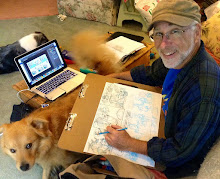

In interviews over the years Neal Adams has voiced his admiration for the work of Norman Rockwell, describing him as a consummate story-teller. On that score you get no argument from me-- or those zillions of other calendar/poster purchasing consumers. Rockwell's continued popularity resides in the clarity of his narrative, the familiarity of his characters and the innocent humor with which he presents depression-era America.
Every aspect of a Rockwell image contributes to the story he is telling--from the obvious details-- such as the facial expressions of his characters, their postures, the clothes they wear--to those that are more subtle;-- the time, the place, the details of the setting. In Rockwell's world- all of the elements are explicit--so that there is no mistaking where, when or what. This explicitness extends to the manner by which he handles his materials as well, reigning in any expressive capabilities of his brush and paint, lest they clutter the canvas and distract from the narrative.
The painter Edward Hopper also mines the terrain of that period-and while he is certainly admired, it would seem odd to say he was popular. He too tells a story, and depicts an America that is familiar --and while one could repeat many of the same words used above to describe Hopper's use of detail- the end result is something quite different. And that difference resides in Hopper's inclination to be circumspect, to imply rather than explain.
It would be a mistake to say that Hopper simply plays with ambiguity for its own sake. His images are filled with questions, questions that arise not only because of his discreetness but also because of his interest in the ineffable, his deep feeling for light--and time. He uses paint to encapsulate the mystery of light upon a door , not to paint the door.
Rockwell's narratives-as pleasing and comforting as they are--conform to well-known archetypes, to an idea of a mythic America that is well-known. Every thing he depicts is complete, defined-- according to the needs of his narrative -and his audiences'expectations. He uses paint to satisfy expectation-- to define his objects, settings and people so well that questions are resolved apriori .
It is not only this-but the character of the questions Rockwell addresses: "what does an archetypal awkward teenager(of the depression-era) wear on a prom or first date? Where would they go? Who would be there? What would they say? How would they interact? What kind of soda would they drink?" -- that are both the source of his success as an illustrator--and the limitation of his art.
With Hopper we are left to wonder. The place and time are familiar to us-we recognize the light of morning, the brownstone rooftops. But the light-- seems not to define setting so much as to penetrate the inner life of the figure, to illuminate the relationship between the figure and the ineffable; inquiry and contemplation, the known and the unknowable.


No comments:
Post a Comment